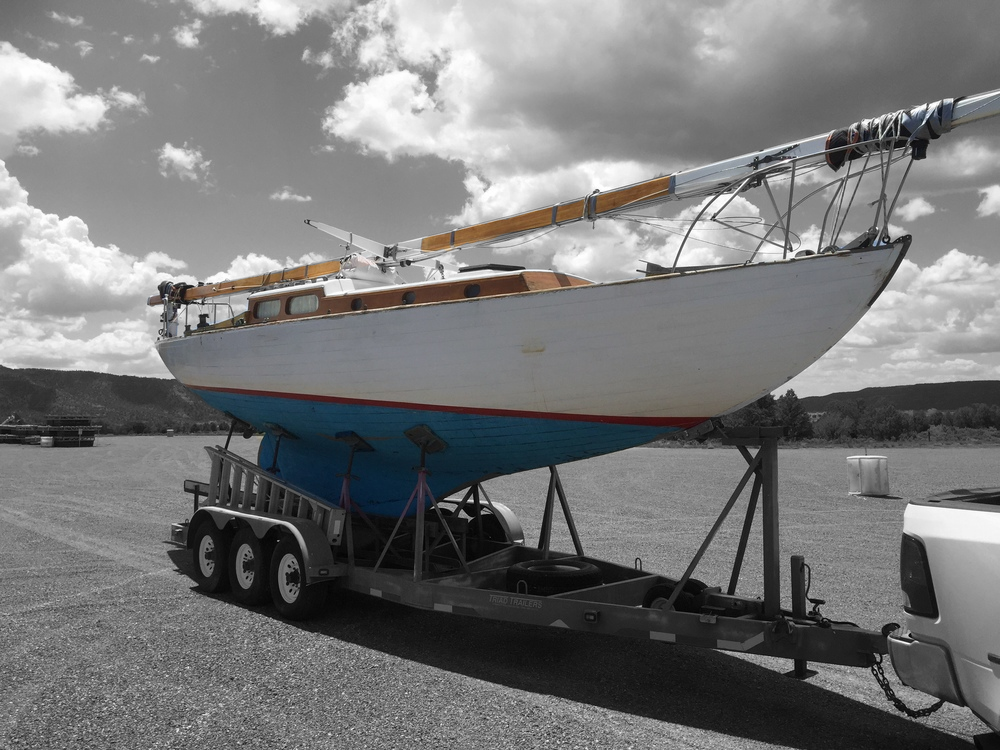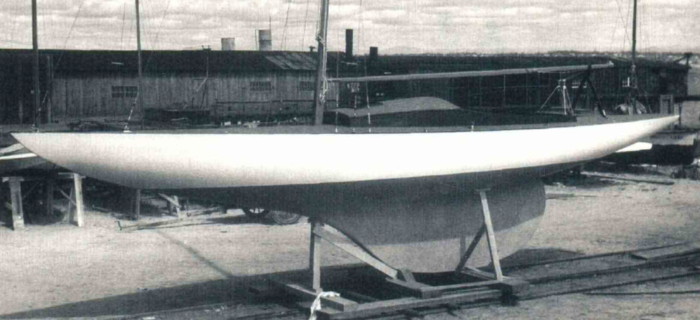
Sail Number: K38/7
Type: Kettenburg K38 Sloop
LOA: 38′ 0″ / 11.58m – LOD: 38′ 0″ / 11.58m – LWL: 26’6″ / 8.07m – Beam: 8′ 0″ / 2.43m – Draft: 5″ 2″ / 1.57m – Displacement: 11,000 lbs – Ballast: 4,000 lbs – Sail AreaL 538 sq ft – Hull material: Wood – Designer: Paul Kettenburg – Built by: Kettenburg Boat Works, San Diego, CA – Year Launched 1951 – Original Name: Echo – Original Owner: Russel H. Huff – Current Name: Blue Heron, Jr. – Current Owner: Thon Deboer
Historical
Echo was designed, built & launched.in 1951 by Kettenburg for Russel H. Huff, She is known now as Blue Heron, Jr., hull number 7 of 36 that were built.
Kettenburg Boat Works:
Thon DeBoer – Transplants from Pennsylvania, the Kettenburg family moved to the Point Lorna (now Point Loma) peninsula of San Diego, California in 1912. George Kettenburg, Sr. had sold his “electricity-generating” business in Pittsburgh and was able to retire in California at the age of 40, lucky B’tard! He had an interest in speedboats and before long he had started building a 22′ powerboat from a plan. His son, George Jr. was helping out at age 14 and soon showed a remarkable propensity and insight in ship design and he convinced his father to extend the boat from 22′ to 24′, under protest by the original designer. Soon, George Jr. had designed a 26-footer and was promptly built and fitted with a surplus WWI aircraft engine as well. After the third design by George Jr. the Kettenburgs started the “Kettenburg Boat and Engine Co.” in 1918 to concentrate fully on the designing and building of boats. Mostly powerboats at first but in 1926 the first 22′ Alden sloop was commissioned by a group of local yachtsmen and the Kettenburgs were on their way to become preeminent sailboat designers and builders.

The Kettenburgs moved their establishment to waterfront property in Point Lorna (Loma) in 1929 and changed their name to “Kettenburg Boat Works”. They were challenged by the San Diego Yacht Club to come up with a design that could race successfully against other, well-established classes, such as the 22-square meter and an R-boat. George Kettenburg, Jr. designed the PC prototype sailboat which easily won and the Kettenburgs had immediate orders for four more boats.
Unfortunately, the depression soon resulted in dried-up orders for the PC and George Jr. cast his eye to a scaled down version of the classic Star and developed the Starlet. The reduced size and simpler design made it more economical to build and buy. The keel was a simple steel plate that was simply bolted to angle irons on the hull bottom and it was also more easily righted in case of a knockdown. 30 of the Starlets were build for the San Diego Yachts Club and more were sold in later years.
After the depression the build up to World War II required a retooling of the Kettenburg Boat Works to be able to deliver the various boats they build for the military on time. They switched from the traditional “right side up” approach to a more modern production line utilizing inverted rigs and separated production zones. This new procedure and retooling allowed the Kettenburg Boat Works to turn out one rearming boat every four to five days and a fishing boat every ten days and the new manufacturing scheme was perpetuated after the war to produce sailing yachts, like the K38 and PCC.

George Jr. correctly sensed the pent-up demand after Word War II for more luxurious racer-cruisers and started the design of the Pacific Cruising Class, or PCC and the first PCC was launched in 1946.
Paul Kettenburg had re-joined the Kettenburg Boat Works in 1943 after having left the company to go work for General Electric in the lean depression years and by 1949 Paul was convinced there was a place in the lineup for a sloop between the 42′ PCC and the 32 ‘ PC hull for about 60% of the cost and water displacement. Together with Charlie Underwood, who had joined the company that year, Paul developed the lines and layout of what would become the Kettenburg K-38 while Charlie saw to the styling and George Jr. oversaw the production. The name K-38, while obviously referring to being a Kettenburg 38-foot sloop also was chosen because it resembled the the famous aircraft designation P-38 which resonated very well with the postwar, aviation conscious Californians.
The K-38 was a hit from the start. A half-dozen people that dropped by to see the half finished K-38 were so impressed with its look that they signed up for buying one of the eventually 36 built hulls right there and then.
Provenance (The Wall of Remembrance – The Owners, Crew & Notable Guest):
Owner/Guardian: (1951) – Russel H. Huff
Owner/Guardian: Malcom “Micky” Warde
Owner/Guardian: Donna Anderson/Arlon Johnson
Owner/Guardian: (2001) – Frank Weis
Owner/Guardian: (current) – Thon Deboer
Haul out from Thon de Boer on Vimeo.
